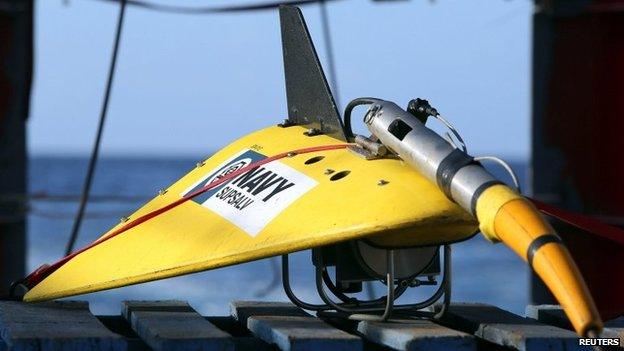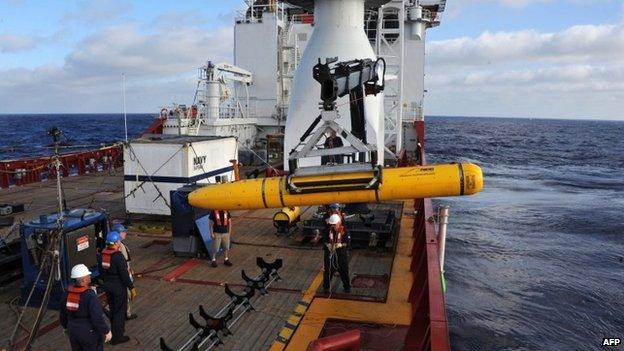Malaysia missing MH370 plane: 'Ping area' ruled out
- Published
Australian Deputy PM Warren Truss says that "No signs of aircraft debris" have been found
The area where acoustic signals thought linked to the missing Malaysian plane were detected can now be ruled out as the final resting place of flight MH370, Australian officials say.
The Bluefin-21 submersible robot had finished its search of the area and found nothing, they said.
Efforts would now focus on reviewing search data, surveying the sea floor and bringing in specialist equipment.
Flight MH370 went missing on 8 March as it flew from Kuala Lumpur to Beijing.
Using satellite data, officials have concluded that the airliner, which had 239 people on board, ended its journey in the Indian Ocean, north-west of the Australian city of Perth.
No trace of the plane has been found and there is no explanation for its disappearance.
'Discounted'
Four pings that officials believed could be from the missing plane's "black box" flight recorders were heard by search teams using a towed pinger locator device.
These pings were used to define the area for the sea-floor search, conducted by the Bluefin-21. It had scoured over 850 sq km of the ocean floor, JACC said.

The depth numbers in the map are estimates, with 95% of the view built from satellite altimetry data

The towed pinger locator was deployed in an area defined by satellite data from the missing plane

After the pinger locator heard signals, the robot submersible Bluefin-21 was deployed
"Yesterday afternoon, Bluefin-21 completed its last mission searching the remaining areas in the vicinity of the acoustic signals detected in early April by the towed pinger locator," a statement from the Joint Agency Co-ordination Centre (JACC) said.
"The data collected on yesterday's mission has been analysed. As a result, the JACC can advise that no signs of aircraft debris have been found by the autonomous underwater vehicle since it joined the search effort.
"The Australian Transport Safety Bureau (ATSB) has advised that the search in the vicinity of the acoustic detections can now be considered complete and in its professional judgement, the area can now be discounted as the final resting place of MH370."
Australia's Deputy Prime Minister Warren Truss said the search had been based on "the best information available at the time".
The statement came hours after a US Navy official told CNN that the acoustic signals probably came from some other man-made source.

Jonathan Amos, BBC News science correspondent
The failure of the autonomous sub Bluefin-21 to find any wreckage in the ping search zone is a hammer blow to the families. It's also a sharp reminder to everyone of just how difficult this whole exercise will be.
Were the pings real or were they simply spurious, a misinterpretation of sound in what is already a very noisy environment? The investigating teams will review again all their data. They will not jump to immediate conclusions. The water column can do strange things with sound, sending it in unexpected directions. The teams will be mindful also that the Bluefin-21 was at times operating beyond its qualified limits.
The authorities have now recognised the need to make a proper bathymetric (depth) survey of the wider search zone - some 60,000 sq km in area.
It will take at least three months, but once they know precisely the shape and depth of the sea bed they can then better choose the most appropriate vehicles to continue the underwater sweep. Wreckage could be in a ravine, covered by shifted sediment. Without the right tools, the job of finding MH370 will be that much harder.

"Our best theory at this point is that [the pings were] likely some sound produced by the ship... or within the electronics of the towed pinger locator," Michael Dean, the US Navy's deputy director of ocean engineering, told the US broadcaster.
"Always your fear any time you put electronic equipment in the water is that if any water gets in and grounds or shorts something out, that you could start producing sound," Mr Dean said.
A US Navy spokesmen subsequently described his comments as "speculative and premature".
In its statement, JACC said an expert working group would continue to review and refine existing data to better define a search area for the missing plane.
A Chinese ship had already begun mapping an area of ocean floor in a survey process that was expected to take three months.
Meanwhile, the ATSB would soon seek bids from commercial contractors for the specialist equipment needed for the underwater search - a process expected to begin in August, JACC said.